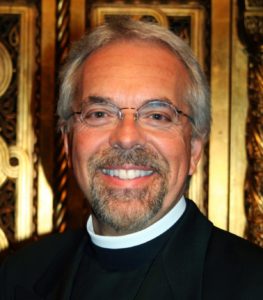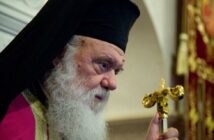Source: OINOS Educational Consulting
by Frank Marangos, D.Min., Ed.D., FCEP
We are too pleased with ourselves,
When our dreams have come true
Because we dreamed too little,
When we arrived safely
Because we sailed too close to the shore.Disturb us, Lord, when
with the abundance of things we possess
We have lost our thirst
For the waters of life;
Having fallen in love with life,
We have ceased to dream of eternity
And in our efforts to build a new earth,
We have allowed our vision
Of the new Heaven to dim.
Disturb us, Lord, to dare more boldly,
To venture on wilder seas
Where losing sight of land
We shall find the stars.
The horizons of our hopes;
And to push back the future
In strength, courage, hope, and love.
This we ask in the name of our Captain.
Disturb Us, is the name of a prayer written in the 16th century by the famous sea captain and explorer Sir Francis Drake. Centuries later, in 2017, a wonderful song with the same title was recorded by the gospel singer and five-time Grammy Award-winning songwriter, Larnelle Steward. Both the prayer and the song were well received because they remind us of how we often get off course in life, business, relationships, vocations, and, most importantly, from God. Drake’s famous prayer beautifully captures the truth. That sometimes, we do need to be disturbed, disrupted, and unsettled, so that we can navigate and recalibrate the course heading of our life.
Surprisingly, the commemoration of Drake’s death in 1596 occurred just a few days ago, on January 28. Francis was initially a young English explorer and privateer who was later celebrated for his circumnavigation of the world in a single expedition between 1577 and 1580. Having started as a simple seaman, Drake fought against the Spanish Armada and became a vice-admiral. Because of his courageous exploits and expeditions, Drake was finally knighted by Queen Elizabeth I.
This edition of Frankly Speaking will examine the significance of being disturbed, and, more specifically, the value for religious communities and faith-based nonprofits of spending time to reflect on the experiences of cultural, organizational, professional, and spiritual disruptions. I want to start by outlining a well-known story that illustrates the prospects associated with disruptive forces.
Dorothy is a simple farm girl living in Kansas with her aunt, and three hired hands. She is convinced, “there is no place like home,” and the certainty of this sentiment finds its definition through the close connection of family, the familiar landscape of surrounding fields, and the faithful following of a beloved dog named Toto.
The Wizard of Oz is a well-known film that effectively illustrates the possibilities of disruption. Most significantly, this is achieved in the single most astonishing shot when Dorothy opens her family’s farmhouse door to reveal a Technicolor world. It is only after Dorothy crash-lands in the land of Oz that the black-and-white film switches to color. The message is clear. Disruption provides the opportunity to transform the dull and dim into dramatic . . . the drab into the dazzling!
While tornados will not necessarily be our cause of disruption and unease, the point is that in life, some applied force(s) will, nonetheless, one day “unsettle” the familiarity of our respective “Kansas-es.” In one moment, everything will be comfortable and safe. Then, suddenly, in the words of Sir Francis Drake, we will find ourselves navigating “wilder seas.” Life, as we know it, will have been disturbed, and new star coordinates required.
As Dorothy learns, there is no turning back, returning to the familiar, or at least, we would be hard-pressed to do so simply by clicking magic heels. The dazzle of a multi-colored future must involve the turning of the rudder, a re-calibration of the sails, and a re-tuning to a new spiritual frequency.
Disruption is often defined “as an action or force that prevents something, especially a system, process, or event, from continuing as usual or as expected.” The consequence of disruption varies with the surroundings and the extent of the disturbance implied. Some disruptions are a must and generate progress, whereas others lead to deleterious personal, organizational, and/or social unrest.
For Sir Francis Drake, disruptions are positive and occur when: (1) we have sailed to close to shore, or (2) when our vision has become too dim. Disruption, he suggests, may also follow because of losing sight of land and stars, that is, life’s familiar moorings. And finally, disruptions, he warns, are caused by the loss of spiritual thirst!
Religious communities and faith-based nonprofits spend much of their time and resources helping people navigate such painful life disruptions, especially ones that result from the paucity of spiritual thirst. Experience reveals a clear pattern for successfully navigating through these and other high winds.
Perhaps the most prevalent is that individuals who successfully pass through the difficulties associated with life’s disruptions had already nurtured the knowledge, skill, and practices of what I would refer to, using Drake’s nautical imagery, as “navigational jibing and tacking.” In short, much like training for a marathon, they had conditioned their minds, bodies, and attitudes to effectively navigate the strong gales of difficult circumstances long before disruption hit.
In order to successfully navigate thru and/or prepare ourselves and our organization for future disruptions, I would recommend the development of Four Core Habits that allow disturbances to become transformative.
The First Habit entails the ability to see life’s disruptions and disturbances as being done “for” rather than “to” us. Although challenging to develop, when our perspective moves from a “to me” to a “for me” attitude, disruptions may begin to be understood as a gift, as a valuable opportunity, rather than an obstacle to evade at all costs. Instead of wasting vital life energy clinging to what should have been, or what might negatively happen, we become curious, open, and affable to the varied lessons and breakthroughs for us and our organizations.
Whatever the case, research, unfortunately, indicates that as humans, we are neurologically wired to resist change. It can, therefore, be quite challenging for us to let old traditions, habits, and attitudes go. Nonetheless, the ability to avoid a “woe is me attitude” is critical. Regrettably, it seems that the harder we resist, the more disrupted, dislocated, distressed, and disturbed we become. In any event, it would be healthier to just allow disruption to be our definitive trainer rather than our most formidable wrestling opponent.
DEALING WITH DISRUPTIONS (PART 2):
USING LIFE’S DISRUPTIONS TO BENEFIT THE GREATER GOOD
by Frank Marangos, D.Min., Ed.D., FCEP
“Self-authorship is the internal capacity to define one’s beliefs, identity and social relations. This requires people to collect, interpret, analyze, and reflect to form their own perspectives and subsequent interactions and decisions.” ~ Robert Kegan
“Disturb Us – Oh Lord,” is the name of a prayer written in the 16th century by the famous sea captain and explorer Sir Francis Drake. The prayer is a valuable reminder of how we often get off course in life, business, our relationships, vocations, and, most importantly, from God. Drake’s famous prayer beautifully captures this truth: that sometimes we do need to be disturbed, disrupted, and unsettled so that we can navigate and re-calibrate the course heading of our personal and professional lives.
This edition of Frankly Speaking will resume my reflection on the experiences of disruption, and, more specifically, continue describing the 2nd of four core habits that I would suggest can help nonprofit leaders navigate through personal as well as organizational challenges.
Leaders of religious and nonprofit organizations that thrive through disruptive circumstances display the ability to be the author of their own stories. Without being naïve or Pollyannish, the story they tell themselves and the meaning they give to life events that might be out of their control is carefully authored.
In his recent book entitled, Go Boldly: Reflections on a Life of Awe and Wonder (2022), William Shatner, the famous TV and cinema personality, provides entertaining, and informative essays, about the astonishing possibilities of self-authorship. By revealing stories of his life, some delightful, others tragic, the 91-year-old Shatner reflects on what he has learned, and, more importantly, on how valuable it is to apply the joy of self-exploration to our lives. Insightful, irreverent, and, with his “Captain Kirk” style wit, and dramatic flair, Shatner focuses on the value of allowing ourselves to self-narrate the awe-inspiring experiences of life.
Shatner’s book of advice is published at a most opportune time when so many of us are dealing with inflation, job losses, health issues, and more. Nonprofit organizations are respectively dealing with hiring shortages, environmental and social initiatives, fundraising, digital trends in giving, and so on. It can be difficult to be awed by life when what’s happening is difficult and challenging. But Shatner, who has had his share of personal disruptions such as loneliness, grief, and cancer, offers a great piece of advice that has given him hope along life’s journey.
His advice? Shatner says that reflective creativity goes a long way in the pursuit of physical and mental health. “I know that good, healthy aging comes from not being solitary or brooding,” he says, “by using just a little imagination you can compensate for some of the difficult things that happen to us, especially as we get older.” Delightfully, Shatner continues by emphasizing the value of philanthropy. “Whether it’s endangered salmon in British Columbia, the seals in the St. Lawrence River, children who are affected by disabilities, or veterans coming back from wars, everybody needs help,” he says. “So, I do the best I can. There’s nothing better for your brain than trying to help someone else.”
Self-authoring has been used to help people achieve more, while alleviating anxiety about the future through a feeling of clarity of purpose and direction. Research supports Shatner’s belief that people who spend time reflecting and carefully writing about their life’s circumstances become happier, less anxious, less depressed, and physically healthier. They become more productive, persistent, and engaged in life. This is because thinking about where we came from, who we are and where we are headed can help us chart a simpler and more rewarding path through life’s disruptions.
To say we’re living through challenging times sounds like both a cliché and an understatement. News about the lingering effects of the pandemic, economic woes, and bitter political debates have triggered tremendous anxiety and sadness for many Americans.
When leaders of religious and nonprofit organizations honestly look back and reflect, they admit that it is usually when they were forced to navigate the most difficult challenges that they had the opportunity to discover a new perspective and/or grew the most. Of course, amid a crisis, it may not feel that way. But the habits of (1) seeing life’s disruptions and disturbances as being done “for us” and not “to us,” and (2) the ability of self-authoring does help to use Sir Francis Drake’s poetic imagery, to productively navigate through the rough seas and winds of difficult times.
Self-authoring is fundamentally the ability to purposely focus our attention on the present moment and accept it without judgment. Learning to live more in the present is especially helpful when the future is uncertain. Self-authoring has therefore been shown to help reduce physical and psychological symptoms in people facing a variety of challenges, including job loss, divorce, cancer, grief, and chronic pain.
In his book The Evolving Self (1982), the American developmental psychologist Robert Kegan explores human difficulties and suggests a way of navigating life’s problems and circumstances. Kegan was the first to coin the phrase “self-authorship” as the ability of individuals “to shift their meaning-making capacity from outside the self to inside the self.”
Kegan defines Self-Authorship as “a lifelong process of self-evolution. “Instead of depending on external values, beliefs, and interpersonal loyalties,” he said, “self-authorship relies on internal generation and coordination of one’s beliefs, values, and internal loyalties. There are elements of self-authorship,” Kegan insists,” that include trusting our internal voice, building an internal foundation, and securing internal commitments.”
Not every experience allows us to work towards self-authorship. But disruptive experiences do provide the opportunity to look at the world around us and search deep within ourselves in order to develop personal opinions and valuable perspectives. These internal influences and beliefs allow us and our organizations to understand what our core values are, why we have them, and how to use them to overcome difficult challenges.
A true story is told of a dog named Luka, a giant schnauzer who had an infected toe for several months on his back leg. The owner noticed that Luka would tend to drag his back foot, causing him to scrape his toe. As the owner’s vet could not discern the problem, he sent them to a neurologist at Ohio State University.
Luka’s owner was perplexed, however. “Why is the Doctor looking at his head?” He thought. “The problem is at the other end of his body . . . at my dog’s farthest extremity, his toe. Why are you looking at his head when the problem is the toe?” “You don’t understand!” The doctor responded. “Everything in the body goes back to the head. Your head is your command-and-control center that sends directives to every part of the body. Something is happening in Luka. There is a little disc in the spine which is not functioning properly and is disrupting the signal from the brain.” One little part in the body can disrupt the signal that is being passed from the head.
In the final analysis, it is the story that we author in our brain that will determine how we walk, stumble, or drag our toes through life’s difficult circumstances. If our personal narrative is not functioning, and not healthy, our navigation will be flawed. It is critical, therefore, that we develop and nurture the Habit of self-authorship by asking ourselves the following two internal questions:
- “What existing story, value, or personal belief is being disrupted by the difficult circumstance that confronts us?” and more importantly . . .
- “What new story can I author that would help me and/or the organization that I serve to thrive?”




